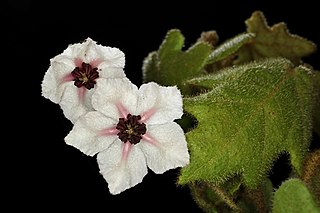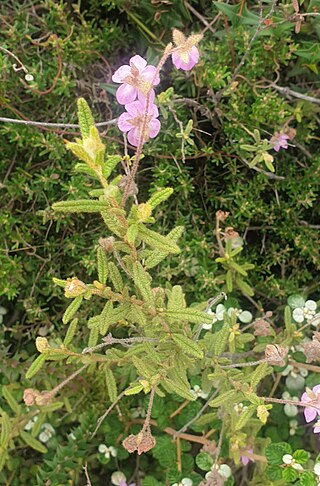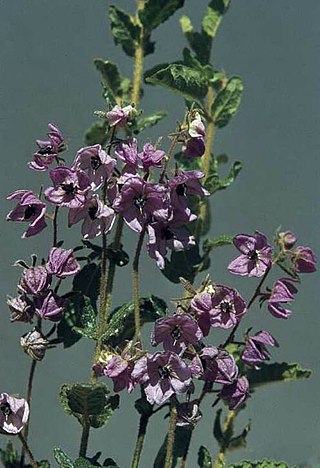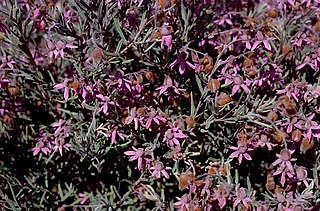
Thomasia tenuivestita is a species of flowering plant in the family Malvaceae and is endemic to the south-west of Western Australia. It is a shrub with its new growth covered with greyish, star-shaped hairs, and has egg-shaped leaves, and racemes of mauve flowers.

Thomasia quercifolia, commonly known as oak leaved thomasia, is a flowering plant in the family Malvaceae and is endemic to the south-west of Western Australia. It has egg-shaped, lobed leaves with a heart-shaped base, and pink to mauve flowers.

Guichenotia ledifolia is a species of flowering plant in the family Malvaceae and is endemic to the southwest of Western Australia. It is a densely-branched shrub with densely hairy new growth, hairy, linear to oblong leaves and pink to mauve flowers arranged in groups of three to ten.

Thomasia solanacea is a species of flowering plant in the family Malvaceae and is endemic to the south-west of Western Australia. It is an erect, bushy shrub with egg-shaped leaves, the bases heart-shaped, and racemes of white, cream-coloured or pink to purple flowers.

Thomasia angustifolia, commonly known as narrow-leaved thomasia, is a species of flowering plant in the family Malvaceae and is endemic to the south-west of Western Australia. It has densely hairy young stems, narrowly oblong, wrinkled leaves and pinkish-purple, bell-shaped flowers.

Thomasia petalocalyx, commonly known as paper flower, is a species of flowering plant in the family Malvaceae and is endemic to southern Australia. It is a shrub with wrinkled, oblong to egg-shaped leaves and cup-shaped mauve flowers.

Lasiopetalum glutinosum is a species of flowering plant in the family Malvaceae and is endemic to the south-west of Western Australia. It is a spreading, multi-stemmed shrub with densely hairy young stems, egg-shaped leaves often with three lobes and bright pink or dark red flowers.

Thomasia brachystachys is a species of flowering plant in the family Malvaceae and is endemic to the Southwest Australia south-west of Western Australia. It is an open, erect shrub with egg-shaped to heart-shaped leaves and pink to mauve flowers.

Thomasia cognata is a species of flowering plant in the family Malvaceae and is endemic to the south-west of Western Australia. It is a compact, multi-stemmed shrub with wrinkled, narrowly oblong to elliptic leaves and pale pink flowers.
Thomasia dielsii is a species of flowering plant in the family Malvaceae and is endemic to the south-west of Western Australia. It is a low, erect to spreading shrub with egg-shaped leaves with wavy edges, and purple, violet and blue flowers.
Thomasia discolor is a species of flowering plant in the family Malvaceae and is endemic to the south-west of Western Australia. It is a small, compact shrub with hairy new growth, heart-shaped leaves with wavy, lobed edges, and pink flowers in crowded clusters.

Thomasia discolor is a species of flowering plant in the family Malvaceae and is endemic to the south-west of Western Australia. It is a multi-stemmed shrub with densely hairy branchlets, coarsely serrated, egg-shaped leaves with a heart-shaped base, and many small pink, cream-coloured or white flowers.
Thomasia × formosa is a species of flowering plant in the family Malvaceae and is endemic to a restricted area of the south-west of Western Australia. It is an erect, compact shrub with densely hairy branchlets, hairy, coarsely serrated, egg-shaped to elliptic or oblong leaves, and racemes of pink or purple flowers arranged in leaf axils.

Thomasia macrocalyx is a species of flowering plant in the family Malvaceae and is endemic to the south-west of Western Australia. It is an erect, bushy shrub with densely hairy new growth, egg-shaped leaves with a heart-shaped base and lobed or toothed edges, and groups of pale purple to mauve or white flowers.
Thomasia multiflora is a species of flowering plant in the family Malvaceae and is endemic to the south-west of Western Australia. It is a low, spreading shrub with broadly egg-shaped leaves and mauve flowers.

Thomasia pauciflora, commonly known as few-flowered thomasia, is a species of flowering plant in the family Malvaceae and is endemic to the south-west of Western Australia. It is a slender, erect or straggling shrub with egg-shaped leaves and pink to purple, occasionally white flowers.

Thomasia rugosa, commonly known as wrinkled leaf thomasia, is a species of flowering plant in the family Malvaceae and is endemic to the south-west of Western Australia. It has wrinkled, lance-shaped to egg-shaped leaves with wavy edges, and pink to mauve flowers.

Thomasia stelligera is a species of flowering plant in the family Malvaceae and is endemic to the south-west of Western Australia. It is a low, spreading shrub with scattered, narrowly oblong leaves, and racemes of mauve flowers.
Thomasia tremandroides is a species of flowering plant in the family Malvaceae and is endemic to the south-west of Western Australia. It is an erect or low, spreading shrub with many stems, flimsy, papery, egg-shaped leaves and racemes of papery, mauve to pink flowers.
Thomasia rulingioides is a species of flowering plant in the family Malvaceae and is endemic to the south-west of Western Australia. It is an erect, open shrub with densely hairy new growth, narrowly oblong to narrowly egg-shaped leaves with wavy edges, and pink to purple flowers.














